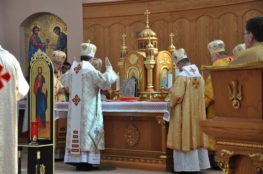There has been a lot of renewed attention on the Second Vatican Council in recent years, prompted by both its various anniversaries (opening, sessions, closing) and Pope-Emeritus Benedict XVI’s calls to interpret the Council in continuity with tradition. Liberals, conservatives, and traditionalists have all weighed-in, offering up various histories, interpretations, and speculations — some far better than others. While I am sure some will accuse me of bias, I still think, pound for pound, Roberto de Mattei’s The Second Vatican Council: An Unwritten Story is the best of the “new” go-to texts on Vatican II. Some folks don’t like his traditionalist bent, but it’s hard to argue with his results.
With that noted, let me direct you to an older, but no less insightful, work that can contribute to our understanding of Vatican II: The Melkite Church at the Council. The full text, including PDFs of all of the chapters, is available from the Eparchy of Newton here. Originally published in French in 1967, this English-language edition, which came out in 1992, features an “Introduction” from the indefatigable controversialist Fr. Robert Taft. While he has much praise to heap on the Melkite Church for what it did (or tried to do) at the Council, Taft reveals what he wished the Council could have fully accomplished with the following:
Ideals always have a head start on reality—that is why we call them ideals, something not yet fully attained, that towards which we strive. So it is natural that certain Melkite ideas advanced at the Council remain undeveloped and unrealized in the Catholic Church: the principle that collegiality should be operative not just among bishops, but on the diocesan level, between the bishop and his presbyterate; that the laity, especially women, should be given their proper dignity and role in church life; that adequate hierarchical provision be made, as a pastoral right and not as a concession dependent on the good will of anyone, for the pastoral care of Eastern Catholics in the diaspora; that a more supple, nuanced view, like that of the Orthodox Churches, be allowed regarding the remarriage of unjustly abandoned spouses; that the problem of the date of Easter be resolved in ecumenical agreement with other Churches; that the Roman Curia assume its proper place within a healthy ecclesiology, no longer operating as a substitute for the apostolic college of bishops, or pretending to possess and exercise incommunicable powers which belong by divine right to the supreme pontiff alone, and cannot be delegated to or arrogated by anyone else.
A few of these points will no doubt raise a few eyebrows. However, for anyone who has followed Taft’s occasionally frustrating and misdirected liturgical-theological career, they shouldn’t be surprising.
What is bound to be a greater surprise — at least to many traditional and conservative Catholics — are the full contents of The Melkite Church at the Council. Some of the most heated and controversial changes to Western Catholic praxis after Vatican II find direct, though maybe not exact, support in this book. Should that temper our attitudes toward these changes or make us more leery of the Melkite Church? Catholics of different stripes will obviously reach different answers, though I would caution all not to be immediately dismissive of what the Melkites had to say during the Council. In many respects the Melkites did faithfully represent the Eastern Christian tradition at Vatican II, though one might wonder what effect that should have had on the life of the Western Church. That the Melkites, like the other sui iuris Catholic churches, should be free to faithfully live out their traditions is not in dispute — not unless that “living out” can’t be accomplished without breaking from the doctrines and disciplines of the universal Church.
Some might wonder if that’s even possible.



